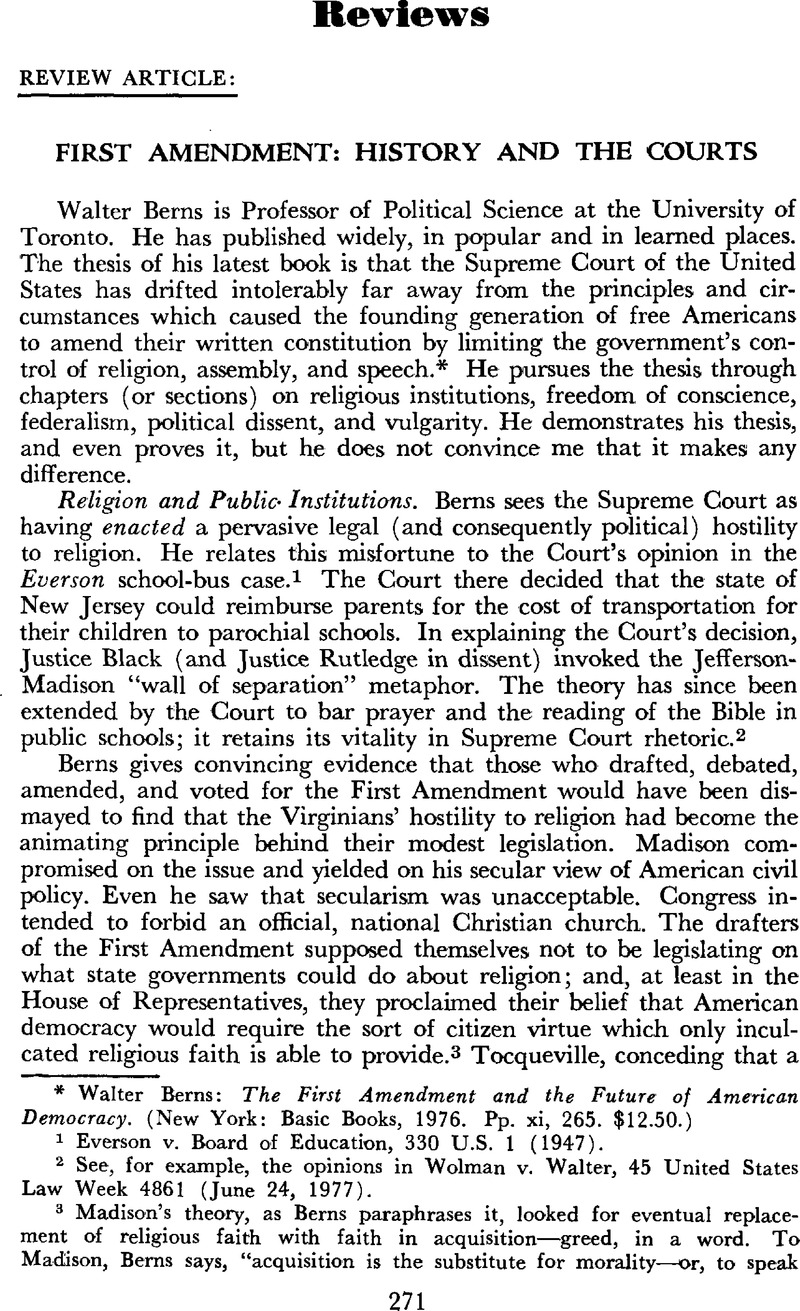No CrossRef data available.
Published online by Cambridge University Press: 05 August 2009

* Berns, Walter: The First Amendment and the Future of American Democracy. (New York: Basic Books, 1976. Pp. xi, 265Google Scholar. $12.50.)
1 Everson v. Board of Education, 330 U.S. 1 (1947).
2 See, for example, the opinions in Wolman v. Walter, 45 United States Law Week 4861 (June 24, 1977).
3 Madison's theory, as Berns paraphrases it, looked for eventual replacement of religious faith with faith in acquisition—greed, in a word. To Madison, Berns, says, “acquisition is the substitute for morality—or, to speak more soberly, was intended to be a substitute for morality” (p. 30)Google Scholar. See note 19 below.
4 Compare Rodes, R. E. Jr, “The Passing of Nonsectarianism—Some Reflections on the School Prayer Case,” Notre Dame Lawyer, 38 (1963), 115Google Scholar; Rodes, R. E. Jr, The Ecclesiastical Administration in Medieval England (1977)Google Scholar, begins a multivolume history which will trace the history of religious establishment from Anglo-Saxon origins to this century in the United States.
5 Wisconsin v. Yoder, 406 U.S. 205 (1972); United States v. Seeger, 380 U.S. 163 (1965); Welsh v. United States, 398 U.S. 333 (1970).
6 Reynolds v. United States, 97 U.S. 145 (1878).
7 Shaffer, T. and Rodes, R. E. Jr, “Law for Those Who Are to Die,” in New Meanings of Death, ed. Feifel, H., pp. 291–311, (1977)Google Scholar: “The … Court … decided in favor of the parents, without going too far into theory. A majority seemed to think high school was not as important as it was cracked up to be … This generation of judges, preoccupied as most of us are with purposes of the living, is not apt to take a firm stand on parental rights. A couple of generations ago, it would have been generally recognized that part of everyone's constitutionally protected freedom was the freedom to decide what his or her children were to grow up to be” (p. 303).
8 R. Browning, “Calaban Upon Setebos: Or Natural Theology in the Island.” SirPollock, Frederick develops the common law idea of due process as one requiring generality, equality, and certainty in his First Book of Jurisprudence (1929)Google Scholar. The Seeger and Welsh cases appeal to that idea, I think. It is an idea which lies deeper in Anglo-American law (and, if you like, in the hearts of people) than the American Constitution does.
9 Boiling v. Sharpe, 347 U.S. 497 (1954).
10 E. Prettyman, Trial by Agency 15 (1959).
11 376 U.S. 280 (1964).
12 Shenck v. United States, 249 U.S. 47, 52 (1919), quoted p. 149: “the most stringent protection of free speech would not protect a man falsely shouting fire in a theatre, and causing a panic.”
13 Gitlow v. New York, 268 U.S. 652, 673 (1925), quoted p. 158.
14 Cohen v. California, 403 U.S. 15 (1971) (clothing); Brown v. Oklahoma, 408 U.S. 914 (1972) (newspaper); Rosenfeld v. New Jersey, 408 U.S. 901 (1972) (legislators).
15 Berns alludes to Miller v. California, 413 U.S. 15 (1973), and Paris Adult Theatre I v. Slaton, 413 U.S. 49 (1973).
16 See, for example, Ginzburg v. United States, 383 U.S. 463 (1966).
17 Compare Red Lion Broadcasting v. Federal Communications Commission, 395 U.S. 367 (1969), with Miami Herald Pub. Co. v. Tornillo, 418 U.S. 241 (1974).
18 See, on this theme, two other reviews of mine, at 18 Journal of Legal Education 492 (1966), and 43 Notre Dame Lawyer 140 (1967)Google Scholar. My favorite cases on a “living Constitution” are United States v. Lovett, 328 U.S. 303 (1946), and United States v. Brown, 381 U.S. 437 (1965), both construing the bills-of-attainder clause (Art. I, Sec. 9, clause 3).
19 Most modern church-state problems can be traced to friction between the nonsectarian, Protestant establishment which emerged from our revolution and the Roman Catholic immigrants of the nineteenth century. A historical analysis which limits itself to the Founding Fathers period leaves out this tension; it tends to make the whole issue appear more bland than it is. See note 4 above. I doubt that the problem among modern justices of the Supreme Court is a failure to understand either historical perspective.